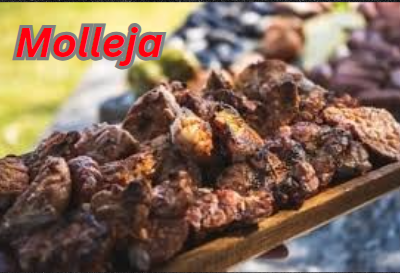In this article, we will explore the fascinating world of molleja, also known as sweetbread, which refers to the thymus and pancreas of beef cattle. We will delve into its culinary uses, nutritional value, preparation methods, cultural significance, and more.
Contents
Introduction
Molleja, or sweetbread, is a delicacy in many cuisines around the world. It primarily consists of the thymus and pancreas glands of beef cattle, prized for their tender texture and rich flavor. In this comprehensive article, we will cover everything from the basics of molleja to advanced culinary techniques, offering unique insights and analyses that go beyond existing information available online.
What is Molleja?
Definition and Types
Molleja refers to two specific glands in beef cattle:
- Thymus (Corazón or Heart): Located near the heart, this type of molleja is often considered more tender and flavorful.
- Pancreas (Cuello or Neck): Found in the neck area, this type has a slightly firmer texture.
Nutritional Value
Molleja is rich in protein, vitamins, and minerals. It is an excellent source of:
- Protein: Essential for muscle growth and repair.
- Vitamin B12: Crucial for nerve function and the production of red blood cells.
- Iron: Important for oxygen transport in the blood.
Culinary Uses of Molleja
Popular Dishes
Molleja is used in a variety of dishes across different cuisines:
- Argentinian Asado: Grilled molleja is a staple in traditional Argentinian barbecues.
- French Cuisine: Known as “ris de veau” in French, it is often prepared with rich sauces and served as a gourmet dish.
- Spanish Tapas: Molleja is sometimes included in tapas, paired with flavorful sauces and spices.
Cooking Techniques
Grilling
Grilling is one of the most popular methods for preparing molleja, especially in Argentina. Here’s how to do it:
- Preparation: Clean and soak the molleja in cold water to remove impurities.
- Marination: Marinate with garlic, lemon juice, and olive oil for enhanced flavor.
- Grilling: Grill over medium heat until golden brown and crispy.
Sautéing
Sautéing molleja in butter or olive oil with garlic and herbs is another delicious way to prepare it. This method brings out the natural flavors and creates a rich, savory dish.
Braising
Braising molleja in a flavorful broth with vegetables and spices results in a tender, melt-in-your-mouth texture. This technique is often used in French cuisine.
Cultural Significance of Molleja
Argentina
In Argentina, molleja is a beloved component of the traditional asado (barbecue). It is often enjoyed with chimichurri sauce and paired with other grilled meats.
France
In France, molleja is considered a delicacy and is often featured in haute cuisine. Chefs create elaborate dishes that highlight its delicate texture and rich flavor.
Spain
In Spain, molleja is enjoyed as part of tapas, where it is often combined with bold flavors and spices to create unique and memorable dishes.
Health Benefits of Molleja
High in Nutrients
Molleja is packed with essential nutrients that offer various health benefits:
- Protein: Supports muscle growth and repair.
- B Vitamins: Aid in energy production and maintain healthy skin and nerves.
- Iron: Essential for preventing anemia and maintaining healthy blood cells.
Low in Carbohydrates
Molleja is a low-carb food, making it suitable for those following a ketogenic or low-carb diet.
Rich in Healthy Fats
The fats in molleja are primarily unsaturated, which can help reduce cholesterol levels and promote heart health.
Buying and Storing Molleja
Where to Buy
Molleja can be found in specialty butcher shops, Latin American grocery stores, and some gourmet markets. When buying molleja, look for:
- Freshness: Bright color and firm texture.
- Cleanliness: Free from excess fat and impurities.
Storing Molleja
To store molleja:
- Refrigeration: Keep in an airtight container in the refrigerator for up to 2 days.
- Freezing: For longer storage, freeze molleja in a vacuum-sealed bag for up to 3 months. Thaw in the refrigerator before use.
Preparing Molleja at Home
Cleaning
Properly cleaning molleja is crucial for optimal taste and texture:
- Soak: Soak in cold water for 2-3 hours to remove blood and impurities.
- Blanch: Blanch in boiling water for a few minutes, then shock in ice water to firm up the texture.
- Trim: Remove any excess fat and connective tissue.
Cooking Tips
- Seasoning: Use simple seasonings like salt, pepper, garlic, and lemon juice to enhance the natural flavor of molleja.
- Temperature: Cook over medium heat to avoid drying out the meat.
- Resting: Let molleja rest for a few minutes after cooking to retain juices and improve tenderness.
Innovative Recipes Featuring Molleja
Molleja Tacos
A modern twist on traditional tacos:
- Ingredients: Molleja, tortillas, avocado, cilantro, lime, and salsa.
- Preparation: Grill molleja and slice into thin strips. Serve on tortillas with avocado, cilantro, lime, and salsa.
Molleja Salad
A light and refreshing dish:
- Ingredients: Molleja, mixed greens, cherry tomatoes, red onion, and vinaigrette.
- Preparation: Sauté molleja until crispy and add to mixed greens with cherry tomatoes, red onion, and vinaigrette.
Molleja Risotto
A gourmet dish perfect for special occasions:
- Ingredients: Molleja, Arborio rice, white wine, chicken broth, Parmesan cheese, and herbs.
- Preparation: Sauté molleja and set aside. Cook Arborio rice with white wine and chicken broth, then stir in Parmesan cheese and herbs. Top with sautéed molleja.
FAQs
What is molleja?
Molleja, also known as sweetbread, refers to the thymus and pancreas glands of beef cattle, prized for their tender texture and rich flavor.
How do you cook molleja?
Molleja can be cooked in various ways, including grilling, sautéing, and braising. It is often marinated to enhance its flavor.
What are the health benefits of molleja?
Molleja is rich in protein, vitamins, and minerals. It is a good source of vitamin B12, iron, and healthy fats, making it a nutritious addition to the diet.
Where can I buy molleja?
Molleja can be found in specialty butcher shops, Latin American grocery stores, and some gourmet markets. Look for fresh, clean molleja with a firm texture.
Can molleja be frozen?
Yes, molleja can be frozen in a vacuum-sealed bag for up to 3 months. Thaw in the refrigerator before use.
Conclusion
Molleja, or sweetbread, is a versatile and delicious ingredient that holds a special place in various culinary traditions around the world. From its rich nutritional profile to its diverse cooking methods, molleja offers a unique dining experience that is both flavorful and satisfying. By exploring its cultural significance, health benefits, and innovative recipes, we hope to inspire you to incorporate molleja into your culinary repertoire.



